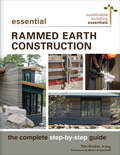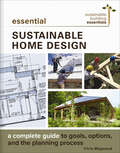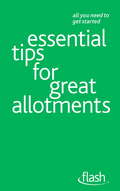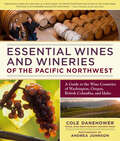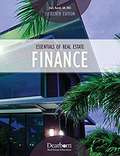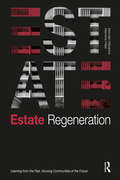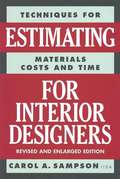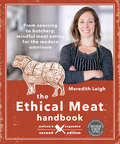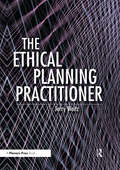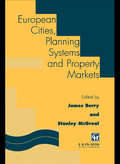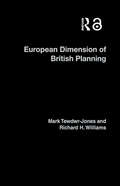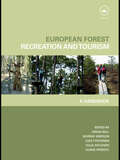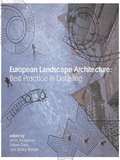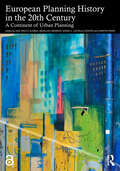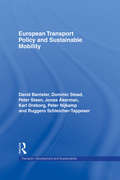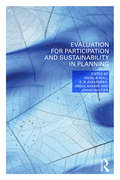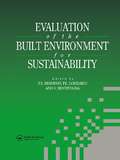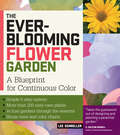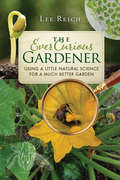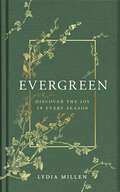- Table View
- List View
Essential Rammed Earth Construction: The Complete Step-by-Step Guide (Sustainable Building Essentials)
by Tim Krahn&“All of the essential knowledge for completing a successful rammed earth project. Written by a geo-technical engineer with experience ramming earth.&” —Kelly Hart, author, Essential Earthbag Construction Everything you need to know to build with rammed earth in warm and cold climates. Rammed earth—sand, gravel, and clay or lime/cement binder packed into forms—is a low-energy, high-performance building method, yielding beautiful, sustainable results. It&’s thermally stable and can be insulated, can actively modulate humidity, provides a healthy indoor environment, and allows site materials to be used for major structural and building envelope elements.Essential Rammed Earth Construction covers design, building science, tools, and step-by-step building methods for any climate, with a special emphasis on building in cold climates of the northern US, Canada, and northern Europe. Coverage includes: Overview of earthen building Appropriate use of rammed earth walls Stabilized versus raw rammed earth Design considerations, including structural, insulation, and building envelope details Special considerations for cold and freeze-thaw climates Construction drawings, with step-by-step building instructions Tools and labor covering industrial methods, low-tech techniques, formwork options, mix design, budgets, and schedules Codes, inspections, and permits. This guide is an essential resource for experienced builders, DIY home owners, designers, engineers, and architects. &“A much-needed and science-based update to a North American audience of designers, engineers and builders.&” —Bruce King. P.E., author, The New Carbon Architecture &“ A great book for anyone who wants to deepen their technical knowledge of rammed earth walls systems. It&’s very helpful to have a book on rammed earth that is more focused on engineered rammed earth walls for cold climates.&” —Clifton Schooley, Clifton Schooley & Associates, Rammed Earth Designers and Builders
Essential Sustainable Home Design: A Complete Guide to Goals, Options, and the Planning Process (Sustainable Building Essentials)
by Chris MagwoodDesign your own sustainable home Many people dream of building a beautiful, environmentally friendly home. But until now there has been no systematic guide to help potential builders work through the complete process of imagining, planning, designing, and building their ideal, sustainable home. Essential Sustainable Home Design walks potential homebuilders through the process starting with key concepts, principles, and a project vision that will guide the house to completion.Coverage includes:How to clarify your ideas and create a practical pathway to achieving your dreamA criteria matrix to guide design, material, and systems decisionsCreating a strong, integrated design team and working with professionals and code officials to keep the project on track from start to finish.Key building science concepts that make for a high-performance, durable buildingPrimer on building logistics, material sourcing, and protocols to ensure that the initial vision for the project comes to fruition.One-page summaries and ratings of popular sustainable building materials and system options.Ideal for owner-builders and sustainable building contractors working with clients aiming to design and build a sustainable home. Chris Magwood has designed and built some of the most innovative, sustainable buildings in North America, including the first off-grid, straw bale home in Ontario. He is co-founder and director the Endeavour Centre for Innovative Building and Living and co-editor of the Sustainable Building Essentials series. Chris is the author of Essential Prefab Straw Bale Construction, Essential Hempcrete Construction, Straw Bale Details, More Straw Bale Building , and Making Better Buildings .
Essential Tips for Great Allotments: Flash
by Geoff StokesThe books in this bite-sized new series contain no complicated techniques or tricky materials, making them ideal for the busy, the time-pressured or the merely curious. Essential Tips for Great Allotments: Flash is a short, simple and to-the-point guide that will teach you all the fundamentals for your allotment, from what tools to use to which crops to grow in just 96 pages. For those new to allotments, this is an ideal starting point for growing your own produce organically.
The Essential Urban Farmer
by Novella Carpenter Willow RosenthalThe "how-to" guide for a new generation of farmers from the author of Farm City and a leading urban garden educator. In this indispensable guide, Farm City author Novella Carpenter and Willow Rosenthal share their experience as successful urban farmers and provide practical blueprints-complete with rich visual material-for novice and experienced growers looking to bring the principles of ethical food to the city streets. The Essential Urban Farmer guides readers from day one to market day, advising on how to find the perfect site, design a landscape, and cultivate crops. For anyone who has ever grown herbs on windowsills, or tomatoes on fire escapes, this is an invaluable volume with the potential to change our menus, our health, and our cities forever.
Essential Wines and Wineries of the Pacific Northwest: A Guide to the Wine Countries of Washington, Oregon, British Columbia, and Idaho
by Andrea Johnson Cole DanehowerSuperbly balanced pinot noirs; crisp rieslings; rich, heady syrahs: these are only a fraction of the expertly crafted wines being produced in the Pacific Northwest's diverse and distinctive wine countries. Second only to California in production, the Pacific Northwest is the largest wine region in North America, home to more than 1,000 wineries. What was once a young wine-growing area with a reputation for eccentricity is today recognized as a dynamic region producing world-class wines, with a focus on ecologically sound practices.This definitive volume profiles the wines, the people who make them, and the wine countries of Washington, Oregon, British Columbia, and Idaho. The journey begins with the region's climates and geology, which create a fascinating tapestry of wine-growing areas. Next, the book focuses on the unique qualities of each wine region, with profiles of more than 160 representative wineries to visit. Included are legacy wineries that helped to build the region’s reputation, prestige wineries with a national presence, under-the-radar artisan wineries that embody the pioneering spirit of the Northwest, and promising new wineries. Each profile lists the winery's signature, premium, value, and estate wines.Beautifully illustrated with photographs and helpful maps, this in-depth guide is a milestone in the North American literature on wine. It will enable wine lovers everywhere to plan their touring, select their wines, and explore and discover the riches of the Northwest's wine country.
Essentials of Real Estate Finance
by Doris BarrellThis dynamic textbook combines solid concepts of real estate finance, but it also gives you a solid foundation for a career in real estate. In this course, you will learn about monetary systems, primary and secondary money markets, and sources of mortgage loans. You will also learn about federal government programs, loan applications, processes and procedures, closing costs, alternative financial instruments, Equal Credit Opportunity Act, Community Reinvestment Act, and the state housing agency.
Estate Regeneration: Learning from the Past, Housing Communities of the Future
by Brendan Kilpatrick Manisha PatelOne hundred years ago, the Addison Act created the circumstances for the large scale construction of municipal housing in the UK. This would lead to the most prolific phases of housing estate building the country has ever seen. The legacy of this historic period has been tackled for the last twenty-five years as these estates began to suffer from misguided allocation policies, systemic building and fabric failure and financial austerity. A series of estate regeneration programmes sought to rectify the mistakes of the past. Estate Regeneration describes 24 of these regeneration schemes from across the UK and the design philosophy and resident engagement which formed each new community. A number of essays from a wide range of industry experts amplify the learning experience from some key estate regeneration initiatives and provide observations on the broader issues of this sector of the housing market. Regeneration is inevitable; it is a matter of the form which regeneration should take. The information presented here is a guide to an intuitive approach to estate regeneration which commences with the derivation of strong urban design principles and is guided by real community engagement. The experience presented seeks to learn from the mistakes of the past to create the best possible platform for regeneration of the housing estates of the future.
Estimating for Interior Designers
by Carol A. SampsonThis completely updated and revised edition provides all the basic, nuts-and-bolts information readers expect, along with all-new sections on faux finishing, including trompe l'oeil; Roman shades; and using upholstery fabrics for drapery and bed coverings.
The Ethical Meat Handbook: From Sourcing To Butchery, Mindful Meat Eating For The Modern Omnivore (Mother Earth News Books for Wiser Living)
by Meredith Leigh“Leigh will teach you how to raise animals, butcher them, and cook and cure their meat. Even better, she explains what it means and why it matters.” —Mark Essig, author of Lesser BeastsNutrition, environmental impact, ethics, sustainability—it seems like there’s no end to the food factors we must consider. At the center of the dietary storm is animal-based agriculture. Was your beef factory farmed or pasture-raised? Did your chicken free range, or was it raised in a battery cage? Have you, in short, met your meat?Most efforts to unravel the complexities of the production and consumption of animals tend to pit meat eaters and vegetarians against each other.In this second edition of The Ethical Meat Handbook, Meredith Leigh argues that by assuming responsibility for the food on our fork and the route by which it gets there, animals can be an optimal source of food, fiber, and environmental management. This new edition covers:Integrating animals into your garden or homesteadStep-by-step color photos for beef, pork, lamb, and poultry butchery100+ recipes for whole-animal cookingCulinary highlights: preparing difficult cuts, sauces, and extrasCharcuterie, including history, general science, principles, and tooling upThe economics and parameters for responsible meat productionEating diversely may be the most revolutionary action we can take to ensure the sustainability of our food system. The Ethical Meat Handbook, 2nd Edition challenges us to take a hard look at our dietary choices, increase self-reliance, and enjoy delicious food that benefits our health and our planet.“A powerful, positive book about a powerful, positive alternative, engaging us in shaping a new food and agriculture narrative.” —Jean-Martin Fortier, author of The Market Gardener
Ethical Planning Practitioner
by Jerry WeitzIf a local college gives a city planner tickets to a sold-out football game, is it wrong to take them – even if the planner pays? Should a planning consultant bid on a project that has a clearly unrealistic timeframe? Can a planning director moonlight for another agency? For practicing planners, potential ethics violations abound, and the eye of public scrutiny never blinks. Planners need a guide, and now they have it: the first guidebook based on the current revision of the AICP (American Institute of Certified Planners) Code of Ethics and Professional Conduct. The Ethical Planning Practitioner presents 76 scenarios, all real-life dilemmas based on the code's rules of conduct. Each scenario comes with tools to help planners explore the answers on their own, in a training session, or in a classroom. This vital handbook looks at everyday ethics the way planners need to see them, in black, white, and shades of gray – but most of all, clearly. It will not only instruct but inspire planners to strengthen the public's trust.
European Cities, Planning Systems and Property Markets
by James Berry Stanley McGrealA common theme running through both the market economies of Western Europe and the old command economies of Eastern Europe is the desire to combine local economic development objectives with those of the international investor. It is in this context that the interaction between planning systems and property markets is of paramount importance.
The European Dimension of British Planning
by Mark Tewdwr-Jones Richard H. WilliamsThe UK government of Tony Blair is committed to fostering a European dimension of planning practice. Significant developments in relation to planning within Europe are occurring. The creation of the European Spatial Development Perspective, the reform of the Structural Funds, and the implementation of programmes to foster trans-national co-operation between governments, will all impact on UK government, and on planning system in particular. Even within the UK, devolution and regionalisation will bring new pressures for overall co-ordination on the issue of European spatial planning. Issues concerning the revisions of the Structural Funds in 2000 and 2006, and funding opportunities for local authorities, are closely connected with the theme of this book. More importantly, it is expected that the link between funding and spatial policy within British planning will become more clearly defined during this period. The European dimension of British planning, as a consequence, may grow significantly over the next few years.The authors tackle four key issues in their discussion of this topic: * British political attitudes to Europeanisation issues* The changing relationships between different arms of the state* The often complex interdependencies between tiers of governance* The rapidly changing definition of British urban and regional planning
European Forest Recreation and Tourism: A Handbook
by Simon Bell Murray Simpson Liisa Tyrväinen Tuija Sievänen Ulrike PröbstlIn an increasingly urbanized world more and more people are turning to our forests and woodland for recreation and tourism. Planning and providing for this growing demand poses challenges that need to be addressed by managers and designers alike. Based on a study of forest recreation from across Europe, the editors bring together the expertise of more than eighty leading professionals and academics to provide a clear and concise guide to best practice. Case studies and careful research give a detailed insight into the issues that forest recreation raises, from strategic planning to integration into the existing rural economy. Essential reading for tourism planners, landscape designers and countryside managers delivering forest recreation and tourism.
European Landscape Architecture: Best Practice in Detailing
by Ian H. Thompson Torben Dam Jens Balsby NielsonDrawing together case studies from all over Europe, this text explores the relationship between the overall idea of the landscape architecture for a site and the design of details. Examining concept sketches and design development drawings in relation to the details of the design, the book offers a more profound understanding of decision making through all stages of the design process. The book includes the study of the choice of materials and techniques of construction, and explores the cultural and symbolic significance of such choices, as well as questions of environmental sustainability. With projects analyzed and evaluated here that have won international acclaim, or have been awarded national prizes, European Landscape Architecture is a core book in the study and understanding of the subject.
European Planning History in the 20th Century: A Continent of Urban Planning
by Max Welch Guerra Abdellah Abarkan Castrillo Romón, María A. Martin Pekár Victoria GrauThe history of Europe in the 20th century is closely tied to the history of urban planning. Social and economic progress but also the brute treatment of people and nature throughout Europe were possible due to the use of urban planning and the other levels of spatial planning. Thereby, planning has constituted itself in Europe as an international subject. Since its emergence, through intense exchange but also competition, despite country differences, planning has developed as a European field of practice and scientific discipline. Planning is here much more than the addition of individual histories; however, historiography has treated this history very selective regarding geography and content. This book searches for an understanding of the historiography of planning in a European dimension. Scholars from Eastern and Western, Southern and Northern Europe address the issues of the public led production of city and the social functions of urban planning in capitalist and state-socialist countries. The examined examples include Poland and USSR, Czech Republic and Slovakia, UK, Netherlands, Germany, France, Portugal and Spain, Italy, and Sweden. The book will be of interest to students and scholars for Urbanism, Urban/Town Planning, Spatial Planning, Spatial Politics, Urban Development, Urban Policies, Planning History and European History of the 20th Century.
European Transport Policy and Sustainable Mobility (Transport, Development and Sustainability Series)
by Peter Nijkamp Dominic Stead David Banister Jonas Akerman Karl Dreborg Ruggero Schleicher-Tappeser Peter SteenIt is now widely accepted that transport is becoming increasingly unsustainable and that strong policy intervention is required to reduce both the growth in transport demand and the environmental costs of transport. This book challenges conventional approaches to transport by moving away from trend based analysis towards the use of scenarios to identify alternative sustainable transport futures. It both summaries the development of EU transport policy and presents a critique. The policy context is widened to include the global changes taking place in economics, society and technology. It develops new methodologies for policy making for the next 25 years.
European Valuation Practice: Theory and Techniques
by A. Adair M.L. Downie S. McGreal G. VosThe variability of valuation practice within Europe is perceived as a problem within the globalization of property. This edited textbook examines the practice of real estate valuation in selected countries in Europe. The focus is on countries with well developed real estate markets in which both international and indigenous investors are active. The book is aimed at real estate professionals, financiers, institutional advisers, property researchers and students who require a greater understanding of comparative property appraisal techniques applied across Europe.
Evaluation for Participation and Sustainability in Planning
by Angela Hull E. R. Alexander Abdul Khakee Johan WoltjerPlanning evaluation is required to establish the success of planning interventions – both of physical developments and new approaches. Yet this should not be a task undertaken purely by professionals without participation by those affected by the process and outcomes of the projects. This book provides case studies and advice on how to balance conservation with economic growth, the cost effectiveness of plans alongside the effects upon the community and the importance of engaging with all stakeholders involved in a project. Practical aspects of the evaluation process covered include: how evaluation is used in planning introducing new kinds of information or criteria alternative ways of collecting/presenting information how strategic planning objectives are implemented in local practice. International contributors provide empirical studies and cases of application which are of practical value to those involved in the evaluation of planning. The book concludes by offering a new paradigm – a locally oriented, context-specific, participatory and multi-disciplinary approach to planning evaluation.
Evaluation of the Built Environment for Sustainability
by P. S. Brandon P. L. Lombardi V. BentivegnaSustainability in the built environment is a major issue facing policy-makers, planners, developers and designers in the UK, Europe and worldwide. The measuring of buildings and cities for sustainability becomes increasingly important as pressure for green, sustainable development translates into policy and legislation. The problems of such measurement and evaluation are presented by the authors in contributions which move from the general to the particular, e.g. from a general framework for an environmentally sustainable form of urban development to a specific input-output model application to environmental problems. The book is divided into three parts: the first covers city models and sustainable systems - research programmes, environmental policies, green corporations and collaborative strategies to make urban development more sustainable; part two discusses the problems of evaluating the built environment in planning and construction, covering economic and environmental methods and construction, development and regeneration processes; part three illustrates a number of applications using different approaches and techniques and referring to a range of environmental aspects of the natural and built environment, from maintaining historic buildings to transport management and air pollution monitoring.
The Ever-Blooming Flower Garden: A Blueprint for Continuous Color
by Lee SchnellerMake your garden bloom with spectacular color throughout the entire season. Lee Schneller&’s simple, no-fail formula teaches you how to select flowers and create a blueprint for a garden that will remain vibrant from early spring through the last days of autumn. With strategies and tips for gardens of all sizes and soil types, and a stunning photograph-filled catalog of 220 easy-to-care-for plants, you&’ll have plenty of options for personalizing your garden&’s colorful and long-lasting style.
The Ever Curious Gardener: Using a Little Natural Science for a Much Better Garden
by Lee ReichAn irreverent romp through the natural science of gardening, with eye-opening insight and practical guidance for getting the most out of your plants.Curious why caressing your cucumber plants will help them bear more fruit? Or why you should grow oranges from seed even if the fruit is inedible? Or why trees need to sleep and how to help them? Join acclaimed gardener, scientist, and author Lee Reich on a journey through the delights of your garden in this laugh-out-loud treatise on the scientific wonders of plants and soil.The Ever Curious Gardener includes information on:How to maximize both flavor and nutrition in your garden bountyHelping plants thrive during droughtOutwitting weeds by understanding their natureMaking the best use of compostTips on pruning and orchard careWhy the dead language of Latin can make you a better gardener.
Evergreen: Discover the Joy in Every Season
by Lydia Elise MillenInspired by the wisdom of the natural world, Evergreen is the essential guide for anyone who is looking to unearth their inner strength and bring more joy and contentment into their everyday. Season by season, Evergreen guides you to reconnect with nature and find balance throughout the inevitable ebb and flow of life. From learning to trust your intuition to embracing the power of amateur status, rethinking your relationship with comparison to seeking solitude when you need it, Lydia Millen takes you by the hand and empowers you with the tools to create your own version of an evergreen life.Whether Evergreen finds you at a time of peace and fulfilment or a time of challenge and uncertainty, this book will uplift you with a fresh perspective and be a comfort you can return to in every season of your journey to come.
Evergreen: Discover the Joy in Every Season
by Lydia Elise MillenInspired by the wisdom of the natural world, Evergreen is the essential guide for anyone who is looking to unearth their inner strength and bring more joy and contentment into their everyday. Season by season, Evergreen guides you to reconnect with nature and find balance throughout the inevitable ebb and flow of life. From learning to trust your intuition to embracing the power of amateur status, rethinking your relationship with comparison to seeking solitude when you need it, Lydia Millen takes you by the hand and empowers you with the tools to create your own version of an evergreen life.Whether Evergreen finds you at a time of peace and fulfilment or a time of challenge and uncertainty, this book will uplift you with a fresh perspective and be a comfort you can return to in every season of your journey to come.
Every Day Is Earth Day: Simple Ways to Reduce Your Carbon Footprint
by Harriet DyerFast facts on fast fashion, throwaway plastics, and other climate catastrophes that you can do something about—today. Every Day Is Earth Day is full of simple ways to reduce your environmental impact. From tips on creating a more eco-friendly home and ways to reduce your plastic use, to advice on shopping sustainably, within these pages you will discover everything you need to know to help you make planet-friendly choices and live a more sustainable life. Also included are tips on taking it to the next level and becoming an activist—to effect wider change and encourage businesses and governments to create a future that&’s healthier, safer, and cleaner!
Every Farm a Factory: The Industrial Ideal in American Agriculture
by Deborah FitzgeraldDuring the early decades of the 20th century, agricultural practice in America was transformed from a pre-industrial to an industrial activity. In this study Deborah Fitzgerald argues that farms became modernised in the 1920s because they adopted not only new machinery but also the financial, cultural and ideological apparatus of industrialism.
